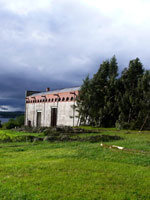Cyprien Gaillard
dal 13/7/2007 al 27/10/2007
Segnalato da
13/7/2007
Cyprien Gaillard
Centre international d'art et du paysage, Ile de Vassiviere
Homes & Graves & Gardens

Homes & Graves & Gardens
curator Chiara Parisi
Homes & Graves & Gardens establishes a continuity between the history of the landscape and that of the island of Vassivière; the villages which were flooded after the building of the dam at the end of the 1940's, which have become underwater tombs; and the garden created on the island, which was mutilated by the storm at the end of the 1990's.
Conceived as a sum of analogies made between different sites – from the housing projects of the Parisian suburbs to Mayan cities, from the lake of Vassivière to the lakes of Yosemite, from the cemeteries of Glasgow to French parks of ruins – Homes & Graves & Gardens seeks to implicate viewers in a dimension which is as physical as it is mental. The artist's aim to is to give the island a new dynamic – from the word dynamite, derived from the Greek dynamikos = force – by offering viewers the possibility of experiencing a day and night of experimentation on an island which has become experimental, where all the aspects of the exhibition will be apprehended according to variable durations and modes.
Cyprien Gaillard has chosen to plunge the exhibition into a nocturnal atmosphere which evokes the scenography of the Wünderkammern , or certain historical collections like that of François I or those of natural history museums. In this environment objects are exhibited which are dead or on the verge of ruin, vestiges of a glorious past and unique memories of vanished lives.
The exhibition Homes & Graves & Gardens is produced in partnership with Naturalia et Pro Natura.
Ping Pang Pong
The artist speaks, the institution invites the public to dialogue
Usually presented on Sunday's afternoon, the Ping Pang Pong program proposes a series of meetings with art's key figures: the artists.
For two hours, international artists answer to the questions of the public, explaining their work through the presentation of images, sounds, videos or performances. A meeting is organized each month by the Centre international d'art et du paysage de l'île de Vassivière.
After Mircea Cantor, Marie Denis, Olivier Bardin, Franck Scurti, Santiago Reyes, Didier Courbot, Davide Bertocchi , Barthélémy Toguo, Shahryar Nashat, Fabien Verschaere, Yann Sérandour, Eric Madeleine, Samon Takahashi, Christelle Familiari, Vincent Lamouroux, Shen Yuan, Michael Herrman, Davide Balula, Paola Yacoub-Michel Lasserre, John Lalor, Jorge Peris, Jakob Gautel, Cesare Pietroiusti and Hans-Walter Müller.
Opening 14 july at 6pm
sound system starting at midnight
Olivier Bardin
What's on view looks like you
Last exhibition: 10 July 2007
Curator Chiara Parisi
In his work, French artist Olivier Bardin uses the exhibition as a medium. Olivier Bardin is known for the exhibitions he has staged, or that he has curated, and for the television programs he has conceived. Using the voice and the image, Olivier Bardin questions the ways identities get constructed through the representations that each makes of him or herself and of others. The image, that of the person, is always at the center of his exhibitions. Real time, short time, the choice of a place, the circulation of the image, and the absence of scenarios are some of the key triggers to the relationships between individuals that Olivier Bardin stages.
What's on view looks like you is the title of a series of four exhibitions staged by Olivier Bardin throughout 2007 at the Centre international d'art et du paysage de l'ile de Vassivière. Every exhibition, which lasts for two hours, takes place in the completely vacant spaces of the museum, and involves a group of no more than twenty viewers each time. The audience is asked one question only: who among you wishes to exhibit him or herself? As soon as a viewer volunteers, the exhibition begins. Originating from a community of viewers, the person who decides to be on view excludes him or herself from the group. The viewers then move away from him/her and watch. After a long silence, like in a museum, the viewers start a discussion with the one who is on view. Through the course of the discussion, which revolves around the responsibility of the viewer's gaze, the person who became the subject of the exhibition returns to his original community. These four exhibitions in V assivière will be documented in a new publication.
Press contact : Frédéric Legros
F - 87120 Ile de Vassivière Phone: (+33) 05 55 69 27 27 Fax: (+33) 05 55 69 29 31 e-mail: communication@ciapiledevassiviere.com
Vassivière Island is 60 km east from Limoges, on the route to Clermont-Ferrand.
By car:
From the north (Paris): highway A20 direction: Limoges, after Limoges exit 35 direction: Feytiat/Eymoutiers, then Beaumont-du-Lac, Lac de Vassivière, Ile de Vassivière.
From the south (Toulouse): highway A20, north of Uzerche exit 42 direction: «Lac de Vassivière» to Eymoutiers then Beaumont-du-Lac, Lac de Vassivière, Ile de Vassivière.
By train:
From Limoges take the train to Eymoutiers train station, direction: Ussel/Clermont-Ferrand. The Centre international d'art et du paysage is 15 km away from Eymoutiers, then taxi (Eymoutiers taxis: phone (+33) 05 55 69 12 04).
By plane:
International airport Limoges
All days: everyday from 11am to 7pm
Admission: full ticket: 3 euros/reduced ticket: 1,5 euros over 12 years, students, unemployed/free: under 12 years, disabled and their companions, Friends of the Centre international d'art et du paysage, members of the Artothèque
Admission: Centre international d'art et du paysage + Château of Vassivière Island : full ticket: 4 euros / reduced ticket: 2 euros



